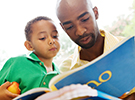Heads or Tails?
In this partnered game, children will flip a penny and collect points, depending on whether the penny lands heads up or tails up.
Lesson for:
Toddlers/Preschoolers
(See Step 5: Adapt lesson for toddlers or preschoolers.)
Content Area:
Data Analysis and Probability
Learning Goals:
This lesson will help toddlers and preschoolers meet the following educational standards:
- Formulate questions that can be addressed with data and collect, organize and display relevant data to answer these questions
- Develop and evaluate inferences and predictions that are based on data
Learning Targets:
After this lesson, toddlers and preschoolers should be more proficient at:
- Sorting and classifying objects according to their attributes and organizing data about objects
- Discussing events related to students’ experiences as likely or unlikely

Heads or Tails?
Lesson plan for toddlers/preschoolers
Step 1: Gather materials.
- Pennies
- Recording Sheet (download here)
Note: Small parts pose a choking hazard and are not appropriate for children age five or under. Be sure to choose lesson materials that meet safety requirements.
Step 2: Introduce activity.
- Demonstrate flipping a coin and calling heads or tails before the coin lands.
- Play a quick game of Heads or Tails before explaining probability and how partners can play the game. Ask all of the children to stand in a circle around you as you flip the coin. Ask how many children think the coin will land heads up. Those children will sit down after the coin is flipped and the children who thought that the coin would land tails up will stay standing. Play this game several times.
- Introduce probability: the chance that something is going to happen. Explain to the children that they are going to explore the concept of probability by flipping a coin and collecting the data.
- Ask the children whether or not they can control which side of the coin lands face up. When they answer, ask: Why or why not? Say: “Heads or Tails is a game of chance. When you play the game, you are going to guess which side will probably land face up. That’s called probability.”
- Give the children examples of probability in real-life scenarios. (e.g.,“The weather man said it will probably rain today, but it may not.”)
Step 3: Engage children in lesson activities.
- Explain that the game will be played in pairs, and that one player will be heads and one player will be tails. Say: “You will play two rounds with 10 penny tosses. You will each get a chance to be heads and you will also get a chance to be tails.”
- Explain the recording sheet. Say: “Player 1 will go first. Before the first roll, Player 1 will decide if he/she wants heads up or tails up. Let’s say Player 1 calls heads. If the penny lands heads up, Player 1 gets a point and records the point in the Player 1 column. If the penny lands tails up, Player 2 gets a point and records it in the Player 2 column.” Show the children the exact columns that you are referring to as you explain the directions. You may want to model a couple of rounds so that the children will get the idea of Player 1 playing for 10 coin tosses and then Player 2 taking his/her turn.
- When the children are done playing, ask who won each game. Say: “Did you think it was a fair game? Why or why not? Do you think you need practice to get better at this game? Why or why not?”
Additional Extensions
- Play with two coins. Again, the player calls either heads up or tails up. Both coins need to land on the side the player calls in order for the player to receive a point. If both coins land on the opposite sides, then the other player gets a point. If the two coins land on heads and tails, no one gets a point.
Step 4: Vocabulary.
- Probability: The chance that something is going to happen (e.g.,”What is the probability that the coin will land heads up?”)
Step 5: Adapt lesson for toddlers or preschoolers.
Adapt Lesson for Toddlers
Toddlers may:
- Not yet grasp the concept of probability
- Need help taking turns
- Need the game simplified
Child care providers may:
- Adapt the game to a one-player game. Have just one child count the number of times that the coin lands heads up. As the children begin to understand the concept of probability, add tails up as a counting option as well.
Adapt Lesson for Preschoolers
Preschoolers may:
- Be able to increase their knowledge of probability by adding another variable into the game
Child care providers may:
- Play with two coins. Again, the player calls either heads or tails. Both coins need to land on the side that the player calls in order for the player to receive a point. If both coins land on the opposite sides, the other player gets a point. If the two coins land on head and tails, no one gets a point.
Suggested Books
- That’s a Possibility! A Book About What Might Happen by Bruce Goldstone (New York: Henry Holt and Co, 2013)
- Do You Wanna Bet? Your Chance to Find Out About Probability by Jean Cushman (New York: HMH Books for Young Readers, 2007)
- A Very Improbable Story: A Math Adventure by Edward Finhorn (Boston, MA: Charlesbridge Publishing, 2008)
Music and Movement
Outdoor Connections
Play the game, Fish Tank
Comment on this lesson